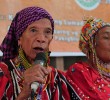Most of all, the BJE recognized the Moro people as the “First Nation,” which Iqbal said, meant they’re the original occupants of Mindanao. The document defines the First Nation as a “domestic community” distinct from the rest of the national community, which has a “definite historic homeland.” The First Nation has a “defined territory” and a “system of government.”
Iqbal claimed the former Sultanates that governed Mindanao had entered into “treaties of amity and commerce” with foreign lands, as proof of this advanced system of government.
In the book “Bangsamoro, a Nation Under Endless Tyranny,” Salah Jubair, (Iqbal’s pseudonym) said the Sulu sultanate, considered even more superior than the Brunei sultanate, ruled the entire Sulu archipelago, Basilan, Mindoro, Palawan and Sabah in 1450.
He said the Maguindanao sultanate, at one time headed by Sultan Dipatuan Muhammad Qudarat, had once controlled the whole of Cotabato, Lanao, Davao, Misamis, Bukidnon and Zamboanga during its grandest time in 1619.
Amirah Lidasan, president of partylist group Suara Bangsamoro, said the BJE is just a piece of paper that recognized the birthright of all Moros as original inhabitants of Mindanao, Palawan and Sulu.
For Lidasan, BJE also defined the ancestral domain of the Moro people, by including those villages where the Moro live.
In the 1890s, the Moro people controlled ninety percent of Mindanao but now they own only about fifteen percent of the land in Mindanao, Lidasan pointed out.
Among the Bangsamoro people are 13 ethnolinguistic tribe which include Kalbogan, Jama Mapun, Badjao, Tausug, Samal or Sama Bangingi, Maranao, Iranon, Maguindanao, Yakan, Sangir, Kalagan, Palawanis and Molbog in Palawan.
Lidasan referred to the Sulu sultanate, founded in 1450, as the oldest and the most developed.
Jubair said that before the turn of the 20th century, the Moros owned ninety-eight percent of the lands in Mindanao and Sulu but several land laws during the American colonization have taken the land away from them.
Public Land Act No. 718, enacted by the Philippine Commission under the Americans, nullified all land grants made by Moro leaders or any Christian tribes without the authority of the state.
The Mining Law of 1905 declared all public lands free, open for exploration, occupation and purchase. This particularly included Mindanao.
Commonwealth Act No. 141 limited the lands that the Moros could apply for titling to not more than four hectares; while Christian settlers are allowed as much as 24 hectares; and corporations as much as 1,024 hectares.
Several other land laws stole the lands of the Moros for big agricultural corporations, Iqbal wrote.
But Lidasan said the BJE should ensure that the plunder of lands in Mindanao should stop. Lidasan said Suara is wary of the provision in the BJE that continues existing mining concessions and timber licenses.
“How can we say that we are Bangsamoro if the lands where we are standing are already owned by big plantations and mining companies?” asked Lidasan.
Lidasan also said that they are wary of the US government intervening in the BJE because of the provision that allows joint ventures in developing and utilizing the resources.
“Will it still be an ancestral domain if foreign corporations already have claims over the land?” she asked.
Lidasan said the right to self-determination would not be realized if societies under the BJE are still oppressed.
She said that the Moro people continued to be displaced from their communities to give way to projects of big multi-national corporations. She said the government’s all-out war against bandits like the Abu Sayyaf and the Jemaah Islamiya also displaced civilians from their communities.
In 2000, the government’s all-out war against the MILF, killed over a hundred civilians and displaced 100,000 in Maguindanao, North Cotabato, Lanao del Sur and Davao Oriental; the “Silent War” (as she referred to the discreet entry of US troops for counterinsurgency operations) in 2000-2002 in Sulu; the attack of Buliok Complex in February 2003, displaced 160,000 and killed 12 people and nine children in Pikit, North Cotabato and Pagalungan, Maguindanao (Liguasan Marsh) .
In July 2001, the declaration of the “state of lawlessness” in Basilan, Zamboanga city and Sulu, forced 20,000 to leave their homes and led to the illegal arrest of 500 people.
Even the twin bombing of the Davao airport and Sasa wharf in 2003 led to warrantless arrests of Moro people in Cotabato and Davao City, Lidasan said.
The failed signing of the MOA-AD reminds the MILF of the failure of the Moro National Liberation Front’s peace negotiation with the government. If there is a lesson that MILF learned from MNLF, it is that the government will take back what it has conceded once the agreement is signed, Iqbal said.
Nur Misuari, MNLF chair, signed the Final Peace Agreement (FPA) with the Ramos administration in 1996. Iqbal said the Arroyo government cannot be trusted.
But no matter what happened to the MOA-AD, the MILF will continue the struggle for the right to self-determination, which is still the key to a lasting peace in Mindanao, Iqbal said.
“There is no easy path,” he said. “But we will move forward.” (Grace S. Uddin/ davaotoday.com)
Peace Process









